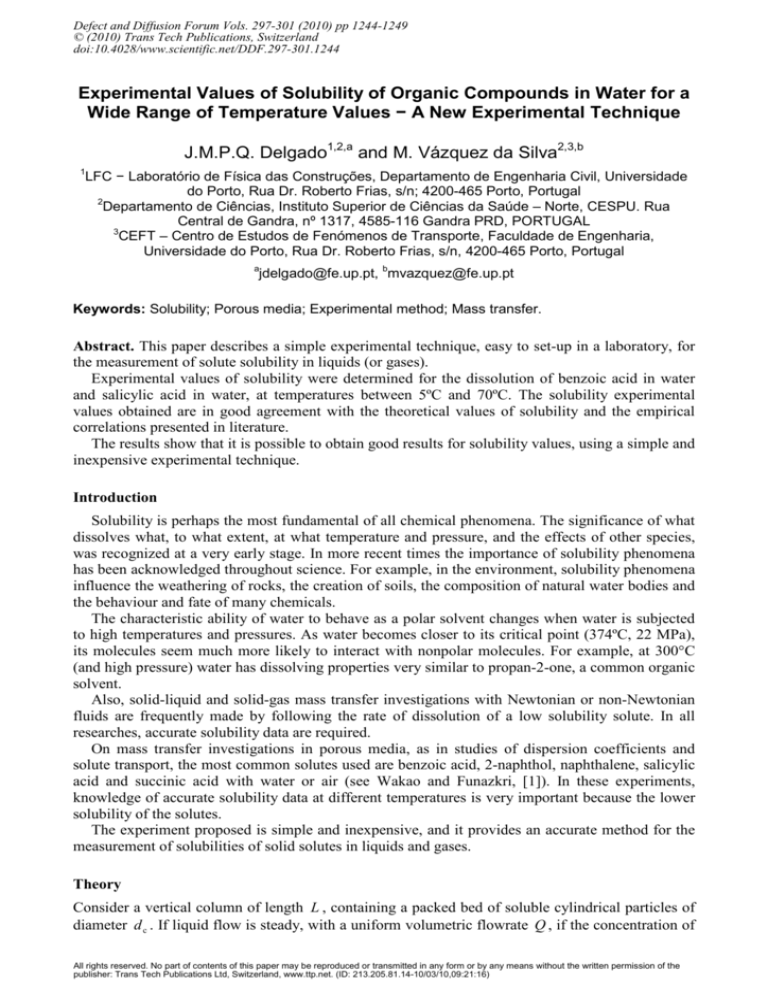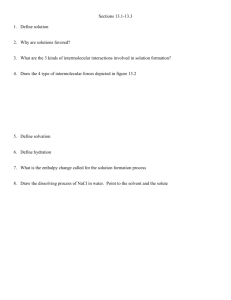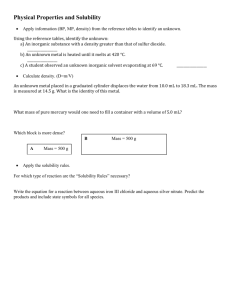
Defect and Diffusion Forum Vols. 297-301 (2010) pp 1244-1249
© (2010) Trans Tech Publications, Switzerland
doi:10.4028/www.scientific.net/DDF.297-301.1244
Experimental Values of Solubility of Organic Compounds in Water for a
Wide Range of Temperature Values − A New Experimental Technique
J.M.P.Q. Delgado1,2,a and M. Vázquez da Silva2,3,b
1
LFC − Laboratório de Física das Construções, Departamento de Engenharia Civil, Universidade
do Porto, Rua Dr. Roberto Frias, s/n; 4200-465 Porto, Portugal
2
Departamento de Ciências, Instituto Superior de Ciências da Saúde – Norte, CESPU. Rua
Central de Gandra, nº 1317, 4585-116 Gandra PRD, PORTUGAL
3
CEFT – Centro de Estudos de Fenómenos de Transporte, Faculdade de Engenharia,
Universidade do Porto, Rua Dr. Roberto Frias, s/n, 4200-465 Porto, Portugal
a
jdelgado@fe.up.pt, bmvazquez@fe.up.pt
Keywords: Solubility; Porous media; Experimental method; Mass transfer.
Abstract. This paper describes a simple experimental technique, easy to set-up in a laboratory, for
the measurement of solute solubility in liquids (or gases).
Experimental values of solubility were determined for the dissolution of benzoic acid in water
and salicylic acid in water, at temperatures between 5ºC and 70ºC. The solubility experimental
values obtained are in good agreement with the theoretical values of solubility and the empirical
correlations presented in literature.
The results show that it is possible to obtain good results for solubility values, using a simple and
inexpensive experimental technique.
Introduction
Solubility is perhaps the most fundamental of all chemical phenomena. The significance of what
dissolves what, to what extent, at what temperature and pressure, and the effects of other species,
was recognized at a very early stage. In more recent times the importance of solubility phenomena
has been acknowledged throughout science. For example, in the environment, solubility phenomena
influence the weathering of rocks, the creation of soils, the composition of natural water bodies and
the behaviour and fate of many chemicals.
The characteristic ability of water to behave as a polar solvent changes when water is subjected
to high temperatures and pressures. As water becomes closer to its critical point (374ºC, 22 MPa),
its molecules seem much more likely to interact with nonpolar molecules. For example, at 300°C
(and high pressure) water has dissolving properties very similar to propan-2-one, a common organic
solvent.
Also, solid-liquid and solid-gas mass transfer investigations with Newtonian or non-Newtonian
fluids are frequently made by following the rate of dissolution of a low solubility solute. In all
researches, accurate solubility data are required.
On mass transfer investigations in porous media, as in studies of dispersion coefficients and
solute transport, the most common solutes used are benzoic acid, 2-naphthol, naphthalene, salicylic
acid and succinic acid with water or air (see Wakao and Funazkri, [1]). In these experiments,
knowledge of accurate solubility data at different temperatures is very important because the lower
solubility of the solutes.
The experiment proposed is simple and inexpensive, and it provides an accurate method for the
measurement of solubilities of solid solutes in liquids and gases.
Theory
Consider a vertical column of length L , containing a packed bed of soluble cylindrical particles of
diameter d c . If liquid flow is steady, with a uniform volumetric flowrate Q , if the concentration of
All rights reserved. No part of contents of this paper may be reproduced or transmitted in any form or by any means without the written permission of the
publisher: Trans Tech Publications Ltd, Switzerland, www.ttp.net. (ID: 213.205.81.14-10/03/10,09:21:16)
Defect and Diffusion Forum Vols. 297-301
1245
solute in the liquid fed to the bed is c0 and the solubility of the solid particle is c * , a mass transfer
boundary layer will develop.
The dissolution of soluble cylindrical particles in liquid flow is given by,
Q
∂c
= kS L (c * − c)
∂x
(1)
where S L is the active surface area per unit length and k is the average mass transfer coefficient.
Given constant flow rate, uniformly distributed particles and isothermal conditions, Eq. (1) is
integrated between the inlet and outlet conditions of the bed, x = 0 to x = L and c = c0 to c = c .
The following equation results,
c − c0
kS
= 1 − exp - L L
*
c − c0
Q
(2)
In order to guarantee that the outlet stream is saturated, it’s important to observe the approximate
criterion (c − c0 ) /(c * − c0 ) > 0.999 (error lesser that 0.1%). The number of soluble cylinders
presented in a packed bed is given by,
n=
Vcolunn 3 (1 - ε ) D 2 L
=
3
Vparticle 2
d1
(3)
and the general validity of the above theory holds, provided that the approximate criterion
6(1 − ε ) kL
> 6.908
u 0ε d1
(4)
If the criterion of Eq. (4) is to be satisfied, it is important to know the value of the average mass
transfer coefficient, k , so as to be able to estimate the interstitial velocity of liquid, u 0 .
Mass transfer from a buried cylinder exposed to cross flow
Consider a long soluble cylinder of diameter d c ( d c = 2 R ) and the fluid flowing around it in the
interstices of a packed bed of inert particles of diameter d ( d << d c ), with uniform voidage, ε (see
Figure 1). The cylinder is immersed in the bed and the fluid flows perpendicular to its axis with
uniform interstitial velocity, u 0 , is imposed, at a large distance from the cylinder.
Darcy’s law, u = − K grad p , is assumed to hold and if it is coupled with the continuity relation
for an incompressible fluid, div u = 0 , Laplace’s equation ∇ 2φ = 0 is obtained for the flow
potential, φ = K p , around the cylinder.
This result is well known to hydrologists and shows that incompressible Darcy flow through a
packed bed follows the laws of potential flow [2]. Darcy’s law is strictly valid only for laminar flow
through the packing, but according to Bear [3] it is still a good approximation for values of the
Reynolds number (based on superficial velocity) up to 10, which for beds with uniform voidage
near 0.4 is equivalent to Re p ≅ 25 , the upper limit for the validity of this analysis.
The solution of the problem is equivalent to a potential flow around a cylinder and in terms of
polar coordinates (r, θ), the potential and stream functions are, respectively (see Currie [4]),
1246
Diffusion in Solids and Liquids V
2
R
r
R 2
ψ = u 0 1 − r sin θ
r
φ = −u 0 1 + r cosθ
(5)
(6)
and the velocity components are given by
R 2
∂φ
= −u 0 cos θ 1 −
ur=
∂r
r
(7)
R 2
1 +
r
(8)
1 ∂φ
= u 0 sin θ
uθ =
r ∂θ
To formulate the mass transfer problem we take the concentration of the diffusing species (the
solute) to be c * on the surface of the cylinder and c0 at a large distance from it, in the approaching
stream. The resulting concentration field will have axial symmetry and the differential equation for
mass transfer may be derived from a mass balance on the elementary volume.
The analysis of mass transfer is based on a steady state material balance on the solute crossing
the borders of an elementary volume, limited by the potential surfaces φ and φ + δφ , and the
stream surfaces ψ and ψ + δψ . In the absence of chemical reaction and for a steady state
conditions the material mass balance on the solute may be expressed as
∂c
∂
∂c ∂
DL
+
=
∂φ ∂φ
∂φ ∂ψ
∂c
DT
∂ψ
(9)
where DL and DT are the longitudinal (axial) and transverse (radial) dispersion coefficients,
respectively. The assumption of steady state is acceptable for a solid that is taken to be slightly
soluble and the use of the dispersion coefficients makes sense if the boundary layer extends over
several particle diameters.
The boundary conditions to be observed in the integration of Eq. (9) are that: (i) the solute
concentration is equal to the background concentration, c0 , far from the cylinder; (ii) the solute
concentration is equal to the equilibrium concentration, c = c * , on the surface of the cylinder and
(iii) the concentration field is symmetric about ψ = 0 , for r > R .
For very low fluid velocities, dispersion is the direct result of molecular diffusion, with
DT = DL = Dm′ , and the numerical solution presented by Delgado [5] applies. The author suggest
that their results are well approximated (with an error of less than 1%) by
Sh'
ε
=
kd c
32
2
= 2 Pe'1/4 + 3 Pe'
εD ' m π
π
1/ 2
(10)
where Pe´= u 0 d c / D´m is the Peclet number for the soluble cylinder.
Now, by substituting the average mass transfer coefficient, given by Eq. (10), into Eq. (4), the
following expression is obtained for the approximate validity criterion of theory developed above:
Defect and Diffusion Forum Vols. 297-301
π 1 dc
1
1 +
>
Pe' 16 Pe'3/4 (1 − ε ) L
1247
2
(11)
Finally, with Eq. (11) we could predict the volumetric flowrates that guarantee saturation in the
outlet stream, Q = Pe' πD 2 εD' m /( 4d c ) . However, an important aspect to consider is the dependence
of Q on the effective molecular diffusion coefficient, D' m . Fortunately, values of D' m increase
with temperature, and the value of D' m , at room temperature or lower, is a good estimate.
Experimental set-up
Experiments were performed on the dissolution of cylinders of benzoic acid and salicylic acid (10
mm of internal diameter and 40 mm of long), buried in cross-flow in beds of sand (0.496 mm
average particle diameter) through which water was steadily forced down, at temperatures in the
range 283 K to 343 K.
A stainless steel tubes (40 mm i.d. and 200 mm long) were used to hold the bed of soluble solid
cylinders in an upright position while a metered stream of distilled water was fed to the top of the
column, as sketched in Figure 1. Near the bottom of the stainless steel column, a perforated plate,
covered with fine wire mesh, was used to support the bed.
The distilled water was initially dearated, under vacuum, to avoid liberation of gas bubbles in the
rig, at high temperature. The test column was immersed in a silicone oil bath kept at the desired
operating temperature by means of a thermosetting bath head (not represented in the figure). The
copper tubing feeding the distilled water to the column at a constant metered rate was partly
immersed in a pre-heater and it had a significant length immersed in the same thermosetting bath as
the test column; the copper tubing leaving the test column was immersed in a chillier to cool the
outlet stream before reaching the UV analyser.
Water
Pre-heater in
silicone oil bath
Flow
meter
Distilled
water
Q
Flow
meter
Valve
Q1
Valve
to UV analyzer
Test columns immersed in silicone oil bath
Figure 1 – Sketch of experimental set-up.
The water flowrate was then adjusted to the required value, Q , and the concentration of solute in
the outlet stream was continuously monitored by means of a UV/VIS Spectrophotometer (set at 226
nm, for benzoic acid and 292 nm, for salicylic acid).
1248
Diffusion in Solids and Liquids V
The solubility of the solutes studied in water was calculated from the steady state average
concentration of solute, cout, in the outlet stream (refrigerated to room temperature), as
c * = (1 + Q1 / Q )cout , where Q and Q1 were the measured volumetric flow rates.
The cylinders of solutes studied were prepared from p.a. grade material, which was molten and
then poured into moulds made of silicone rubber. Wherever any slight imperfections showed on the
surface of the cylinders, they were easily removed by rubbing with fine sand paper.
Results and Discussion
The reproducibility of the experiments was tested by independently repeating the measurement of
solubility under identical operating conditions, and in the vast majority of cases the results of
repeated measurements of solubility did not differ by more than 8%.
if the condition represented by Eq. (11) is observed, each experimental run gives a value of c * .
This requirement meant that extremely low velocities of liquid had to be observed in the
experiments (approximately 0.15 mm/s). As the experiments were carried out with pressurized and
deaerated water, it was possible to work at temperatures up to 373 K. The value ε = 0.40 was taken
from references in the literature [6].
The experimental solubility values obtained for the two organic compounds in water are plotted
as a function of temperature in Figures 2 and 3.
16
14
This work
Dunker [7]
Sahay et al. [8]
Eisenberg et al. [9]
Seidell [10]
12
3
3
c * (kg/m )
10
This work
Eisenberg et al. [9]
Seidell [10]
14
c * (kg/m )
12
8
6
10
8
6
4
4
2
2
0
0
270
280
290
300
310
320
330
340
T (K)
Figure 2 – Solubility of Benzoic acid in distilled
water as a function of temperature.
270
280
290
300
310
320
330
340
350
T (K)
Figure 3 – Solubility of Salicylic acid in
distilled water as a function of temperature.
The results presented in Figures 2 and 3 suggest that our data are consistent and accurate. The
values of c * obtained for benzoic acid in water are in good agreement with the values proposed by
Dunker, Sahay et al., Eisenberg et al. and Seidell [7-10]. For salicylic acid solubility in water the
experimental values obtained are in good agreement with the values suggested by Eisenberg et al.
and Seidell [9,10]. For benzoic acid in water we propose the following equation, using the majority
of the experimental points found in literature,
c* = 1.12 × 10 −4 exp( 0.0346 × T (K) )
(12)
and the data shown in Figure 2 are within 5 % of this line. For salicylic acid in water, no
correlations were found in literature and we propose the following equation, with an error lesser that
5% (see Figure 3),
c* = 4.85 × 10 −6 exp( 0.0432 × T (K) )
(13)
The agreement between our results and other published data suggests that the proposed
experimental method is accurate. However, it is important to remember that, for higher solubility
Defect and Diffusion Forum Vols. 297-301
1249
solutes, natural convection near the surface of the dissolving solids may become significant, thus
invalidating the method.
Conclusions
Experimental values of solubility were determined for the dissolution of benzoic acid in water and
salicylic acid in water, at temperatures between 5ºC and 70ºC, using a new experimental technique.
The main conclusion from this work is that the experimental technique described for measuring
the solubility of an organic compound in a liquid, at different temperatures, is perfectly suitable and
easy to use in laboratory. The experimental data show that it is possible to obtain good results for
solubility values, using this simple procedure.
"omenclature
c
c0
c*
cout
D
Solute concentration
Bulk concentration of solute
Saturation concentration of solute
Concentration in the outlet stream
Diameter of inert particles
Diameter of active cylinder
dc
D
Diameter of test column
DL Longitudinal dispersion coefficient
Dm′ Effective molecular diffusion coefficient
DT Transverse dispersion coefficient
K
k
L
n
p
Permeability in Darcy's law
Average mass transfer coefficient
Length of test column
Number of soluble cylinders
Pressure
Pe ′
Q
r
R
SL
Sh´
Peclet number
Volumetric flowrate
Spherical radial coordinate
Radius of the active cylinder
Surface area per unit length
Sherwood number
T
u
Temperature
Interstitial velocity (vector)
Interstitial velocity
u0
u r , uθ Components of fluid interstitial velocity
ε
Bed voidage
Potential function
φ
Spherical angular coordinate
θ
ω
Cylindrical radial coordinate
ψ
Stream function
References
[1] N. Wakao and T. Funazkri: Chem. Eng. Sci. Vol. 33 (1978), p. 1375
[2] A.E. Scheidegger: The physics of flow through porous media (3rd Edition, University of
Toronto Press, Toronto, 1974).
[3] J. Bear and A. Verruijt: Modelling groundwater flow and pollution with computer programs for
sample cases (D Reidel Publishing Company, 1987).
[4] I.G. Currie: Fundamental mechanics of fluids (McGraw-Hill, New-York, 1993).
[5] J.M.P.Q. Delgado: Heat Mass Transf. Vol. 42 (2006), p. 1119
[6] T.K. Sherwood, R.L. Pigford and C.R. Wilke: Mass transfer (International Student Edition,
McGraw-Hill Kogakusha, 1975).
[7] C. Dunker: Benzoic acid (in Kirk-Othmer Encyclopaedia of Chemical Technology. Second
edition, Interscience Publishers, No. 3, p. 422, 1964).
[8] H. Sahay, S. Kumar, S.N. Upadhyay and Y. Upadhyay: J. Chem. Eng. Data Vol. 26 (1981), p.
181
[9] M. Eisenberg, P. Chang, C.W. Tobias and C.R. Wilke: AIChE J. Vol. 1 (1955), p. 558
[10] A. Seidell: Solubilities of organic compounds (3rd Edition, New York, D. Van Nostrand Co.,
1941).







